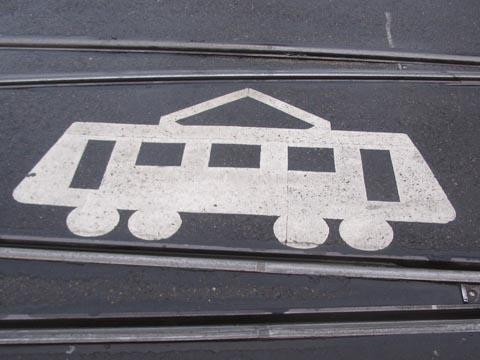
With a view to starting operations towards the middle of this year, work is now underway on the 72m pesos Ferrourbano project to restore 11·5 km of metre-gauge infrastructure for use by passenger services between Rodríguez del Busto and the Mitre and Belgrano stations in the city of Córdoba in Argentina. With a total of six stops, the service will be operated by Ferrocentral (RG 9.07 p525), probably using ex-Portuguese Railways DMUs.
Tram services were launched in the Basque city of Vitoria on December 23 following an inauguration ceremony at the depot, presided by the Regional President Juan José Ibarretxe. The 5 km route between Angulema and Ibaiondo has 12 stops and is operated by 10 metre-gauge trams supplied by CAF. A branch to Abetxuko is due to open in April.
On January 5 the President of Mexico, Felipe Calderón, opened the final two stations on the capital’s commuter line between Buenavista and Cuautitlán. The initial section to Lechería entered service in June 2008 (RG 7.08 p412). Technical studies for a proposed US$400m extension to Huehuetoca have started, and concessionaire CAF is awaiting authorisation to proceed so that work can be completed before the end of 2010.
CityCargo, which envisaged using the Amsterdam tram network to supply shops and businesses, has gone into receivership, although receiver Joris Lensink and Veolia are investigating possibilities to revive the project. The city council has said it sees potential in the project only as an unsubsidised commercial operation, while the chamber of commerce questioned the extra transhipment and tariffs.
On December 30 regional transport body KZK GOP signed a new 15-year contract with Tramwaje Slaskie for the operation of the 200 km tram network serving 12 towns around Katowice. The contract is valued at around 2·9bn złoty, and provides flexibility to vary services to suit changes in travel patterns; Line 12 was closed with effect from January 1 2009. Tramwaje Slaskie is to buy at least 20 low-floor unidirectional trams by 2012, and 20 high-floor cars may also be purchased.
Following the completion of the sale of MÁV Cargo to Rail Cargo Austria (RG 1.09 p7), local media reported that the Hungarian national railway was in discussions with BKV, the Budapest city transport authority, over the purchase of suburban operator HÉV. A price of around HF30bn was suggested, but a MÁV spokesperson told Railway Gazette International on January 16 that there was no truth in the reports.
The Nairobi Metro 2030 Strategy, released on December 15, envisages construction of a light rail network serving ‘all the major suburbs’ to facilitate the city’s aim of hosting the 2018 Commonwealth Games. The overall strategy would cost KSh3320bn, but as yet there are no details on how it would be financed.
Last month regular all-day services were launched on the 8·8 km Cinisello light rail line, operated by ATM Milano as route 31. Limited services began on December 15, after the 4·3 km of new construction through the centre of Cinisello was inaugurated on December 7.
As expected, the US Department of Transportation gave final approval on January 7 for the $5·2bn Dulles extension to the Washington metro. The first phase of the planned line to Dulles International Airport will run from Falls Church via Tysons Corner to Reston. A Full Funding Grant Agreement worth $900m should follow a statutory 60-day review by Congress.
The second phase of the Glattalbahn light rail network in the northern suburbs of Zürich opened on December 14. The 5·7 km route from Oerlikon to Zürich Airport adds to the 3 km first phase from Messe/Hallenstadion to Auzelg (RG 2.07 p74). Although the line has been built by concessionaire Verkehrsbetriebe Glattal, crews and rolling stock are provided by VBZ, which operates the service as an extension of tram Route 10.
The city of Praha has reduced the length of metro Line D, currently under construction, to reduce costs. The line is no longer planned to serve Žizkov and Liben, running instead from Pankrác via Novodvorsko to Modrany and Písnice, possibly as two branches. The line is due to open in 2015.
A consortium of ITNL ENSO Rail Systems and property developer DLF Group is the only bidder for the Gurgaon light metro PPP project in the suburbs of Delhi (RG 2.08 p70). The consortium plans to create a Special Purpose Vehicle to finance construction of the 32 km line, which would connect the Delhi Metro station at Sikanderpur to the Mall of India retail development.
In the latest phase of the Rubin project (RG 2.05 p85), test running in fully-automated mode began on January 13 on Line U2 of the Nürnberg metro. The test trains will initially run empty from 21.00 on weekday evenings to prove the functionality of the control equipment. Trains on Line U3, which shares tracks with U2 in the city centre, are already carrying passengers in automatic mode.
Following a vote on December 18, the local authority in Besançon has approved the construction of a 14·5 km light rail line. The route will cross the French city from Chalezeule in the east to Hauts du Chazal in the west, serving the main line station at Viotte. The authority plans to build an ‘optimised’ tram line with a simple electrical supply system and small depot in an effort to reduce costs.
French Secretary of State for Urban Policies Fadéla Amara announced on January 19 that work would get underway in 2015 on the proposed branch of tram-train line T4 to serve the isolated suburbs of Clichy-sous-Bois and Montfermeil east of Paris, although route options are still under discussion.
The Spanish government has unveiled a €4·2bn redevelopment plan for the Chamartín area of Madrid, covering a 3·1 million m2 site mainly in railway use. As well as the remodelling of the RENFE terminus and the covering over of railway tracks, the plan includes an extension of metro Line 10 with five stations, running along a new 2·8 km section of the Paseo de la Castellana.

















